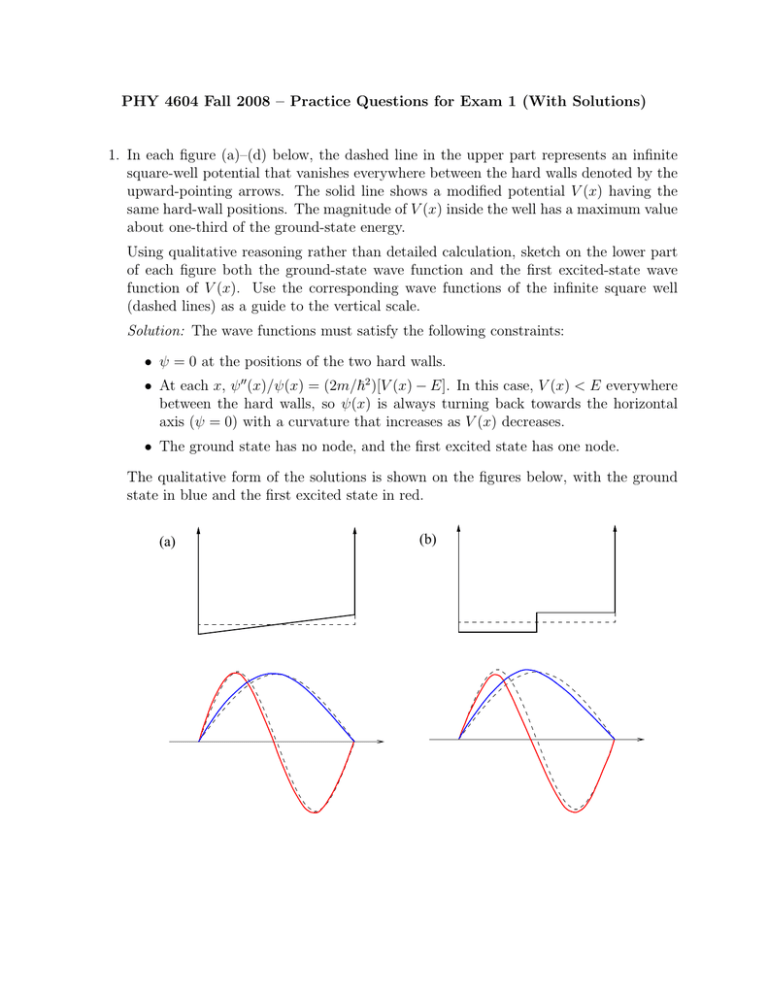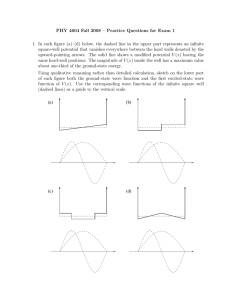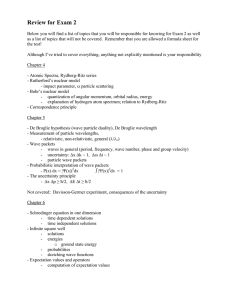PHY 4604 Fall 2008 – Practice Questions for Exam 1 (With... 1. In each figure (a)–(d) below, the dashed line in the... square-well potential that vanishes everywhere between the hard walls denoted by...
advertisement

PHY 4604 Fall 2008 – Practice Questions for Exam 1 (With Solutions) 1. In each figure (a)–(d) below, the dashed line in the upper part represents an infinite square-well potential that vanishes everywhere between the hard walls denoted by the upward-pointing arrows. The solid line shows a modified potential V (x) having the same hard-wall positions. The magnitude of V (x) inside the well has a maximum value about one-third of the ground-state energy. Using qualitative reasoning rather than detailed calculation, sketch on the lower part of each figure both the ground-state wave function and the first excited-state wave function of V (x). Use the corresponding wave functions of the infinite square well (dashed lines) as a guide to the vertical scale. Solution: The wave functions must satisfy the following constraints: • ψ = 0 at the positions of the two hard walls. • At each x, ψ 00 (x)/ψ(x) = (2m/~2 )[V (x) − E]. In this case, V (x) < E everywhere between the hard walls, so ψ(x) is always turning back towards the horizontal axis (ψ = 0) with a curvature that increases as V (x) decreases. • The ground state has no node, and the first excited state has one node. The qualitative form of the solutions is shown on the figures below, with the ground state in blue and the first excited state in red. (a) (b) (c) (d) 2. A particle moves in the one-dimensional potential V (x) shown below. It is in its ground state, which has the energy E indicated by the dashed line in the figure. Sketch the wave function. Solution: The wave function must satisfy the following constraints: • Since E < V (±∞), ψ → 0 as |x| → ∞. • At each x, ψ 00 (x)/ψ(x) = (2m/~2 )[V (x) − E]. In regions where V (x) < E, ψ(x) turns back towards the horizontal axis with a curvature that increases as V (x) decreases. In regions where V (x) > E, ψ(x) turns away from the horizontal axis with a curvature that increases as V (x) increases. • The ground state has no node. The qualitative form of the solution is shown in red on the figure below. Note that since the left well is deeper than the right well but of similar width, the change in ψ 0 (x)/ψ(x) is greater across the left well, leading to a sharper hump in ψ(x). V(x) E x 3. A one-dimensional step potential takes the form 0 for x < 0, V (x) = V0 > 0 for x > 0. A particle of mass m approaches the step from the left with an energy E = V0 . (a) Find the wave function describing this situation. Your solution should contain just one unknown parameter. Solution: The general form of the stationary-state wave function in each region of constant potential is Aeikx + Be−ikx for x < 0, ψ(x) = C + Dkx for x > 0, √ where k = + 2mV0 /~, and A, B, C, and D are complex amplitudes. (The factor of k multiplying Dx ensures that D has the same dimensions as A, B, and C.) We must require D = 0 to prevent ψ(x) from blowing up as x → ∞. Also, we must enforce continuity of ψ(x) and ψ 0 (x) across the potential jump at x = 0. These boundary conditions imply that A + B = C and ik(A − B) = 0, and hence C cos kx for x < 0, ψ(x) = C for x > 0. (b) Find the probability density and the probability current (i) in the region x < 0, and (ii) in the region x > 0. Solution: (i) In the region x < 0, the probability density is ρ(x) = |ψ(x)|2 = |C|2 cos2 kx and the probability current is ~ ~k ∗ dψ j(x) = Im ψ = (|A|2 − |B|2 ) = 0. m dx m (ii) In the region x > 0, the probability density is ρ(x) = |C|2 . It is generally true that ∂j/∂x = −∂ρ/∂t = 0. In any stationary state, ρ is independent of t. Here, this means that j(x) = 0 in the region x > 0 as well. (c) Calculate the particle’s reflection and transmission coefficients. Solution: In the region x < 0, the incident and reflected probability currents are jI = ~k|A|2 /m and jR = −~k|B|2 /m, respectively. Thus, R=− jR = 1 and T = 1 − R = 0. jI








